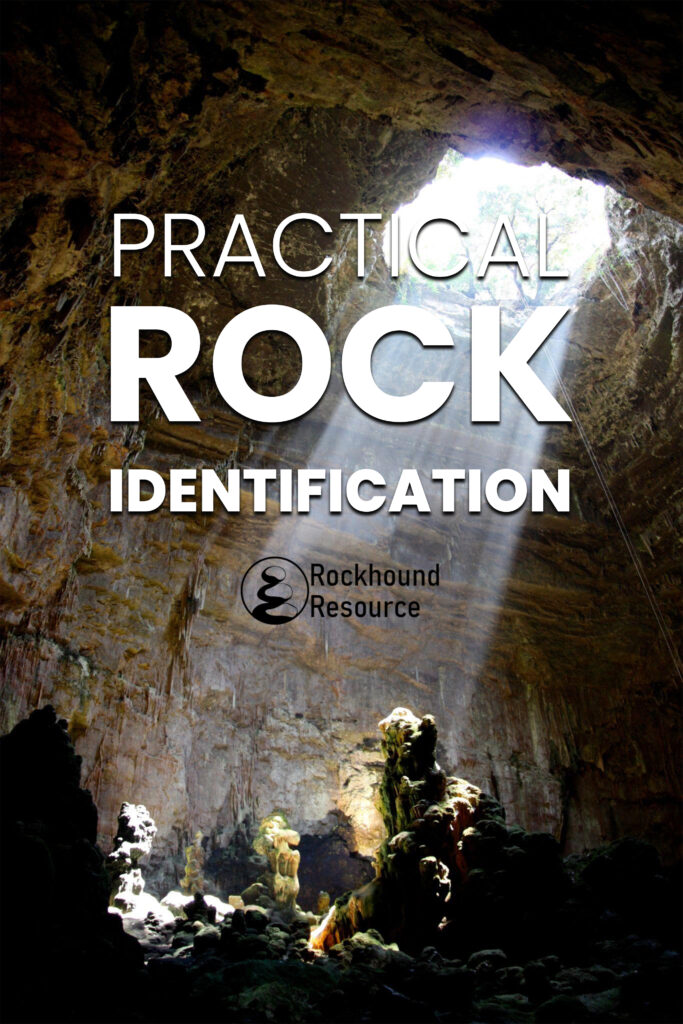One of the most common frustrations we have as rock collectors is identifying the cool rocks we find. It’s fun to discover a cool-looking rock and add it to your collection, but it can often be difficult to know exactly what it is you’ve found. I have found that there aren’t a lot of great resources out there to help rockhounds identify their rocks, so I decided to put together this guide to aid you in figuring out what kind of rocks you’ve found.
To identify your rock, first take note of its physical properties like color, luster, banding, layering, and grain size. Next, test for hardness and weight by running simple tests. Finally, compare the properties of your rock to those of known rock types while looking for other identifying characteristics.
Identifying and classifying rocks can be a tricky business. I have literally written the book on practical rock identification (link to Amazon), but in this article, I’ll go through the complete process you should use, point you toward some useful tools, and give you some generalized pictures for comparison.
Analyze the Physical Properties of Your Rock
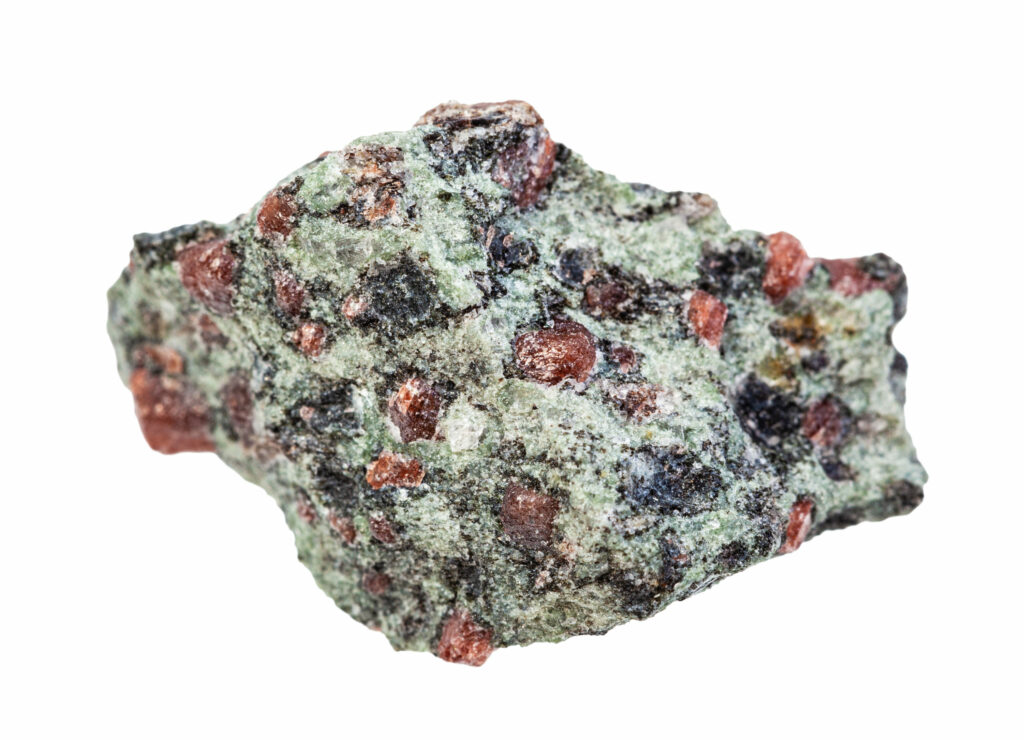
Rocks are classified based on their origin and their physical properties such as mineralogical composition, grain size, and texture. Observing and, in some cases, measuring these physical properties is the first and most important step toward identifying your rock.
Tip: If you’re interested in learning to identify minerals, check out my complete mineral identification guide.
Go through each of these identifying properties and write down your observations. Depending on what type of rock you have not all of these properties will be applicable, but most of them will be.
Once you have gone through this list of physical properties (it should just take a few minutes), consult the tables I have compiled below to find the best match for your rock.
Color
One of the first things you’ll notice about any rock is its color. The color of a rock is often overrated when it comes to identification, but it is certainly an important characteristic that should factor into the process.
Your rock may be one uniform color or it may have multiple colors. Make note of every color you see, but you’ll want to place the most emphasis on the most predominant one or two colors. The different colors are due to the different minerals that your rock is comprised of, and by getting a rough estimate of the percentage of each color in your rock you’ll be able to make some inferences about its mineralogical makeup later on in this process.
TIP: If you’re serious about your rockhounding hobby and you want to learn how to identify rocks as well as most trained geologists, I’d highly recommend that you check out my Practical Rock Identification System. This bundle of information includes my eBook on the subject, informational videos, and powerful online tools to help you identify rocks like a pro.
Sometimes the color of a rock can be deceiving. Many people who are new to rock identification tend to lean too heavily on the color of a rock when trying to determine what it is. Always remember that color is just one of many important physical properties and weigh it accordingly.
It’s also important to make sure you’re looking at a relatively fresh surface on your rock. Some rocks will appear very different on the outside than they do on the inside because the exterior has been weathered and altered by the elements. If possible, break off a small part of your rock to expose a fresh surface – especially if it looks heavily weathered on the outside.
Luster
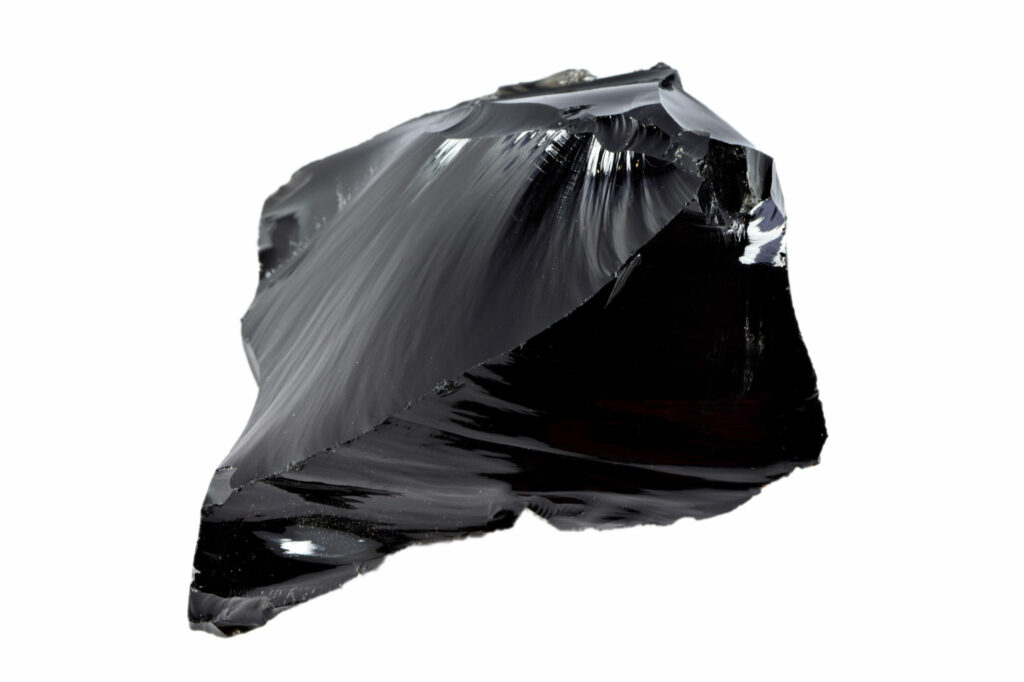
Luster is a property that is more commonly used in the identification of minerals. It describes the way light reflects off of a surface and can be very useful for description and identification.
In the case of your rock, we won’t be using most of the terms and descriptions used for mineral identification. I just want you to take note of how your rock generally seems to reflect light. Is it glassy? Dull? Maybe a little sparkly?
Most rocks will fall under the category of ‘dull’, but there are a few rock types that are easily identifiable based on glassy or slightly sparkly appearances.
Grain Size & Shape
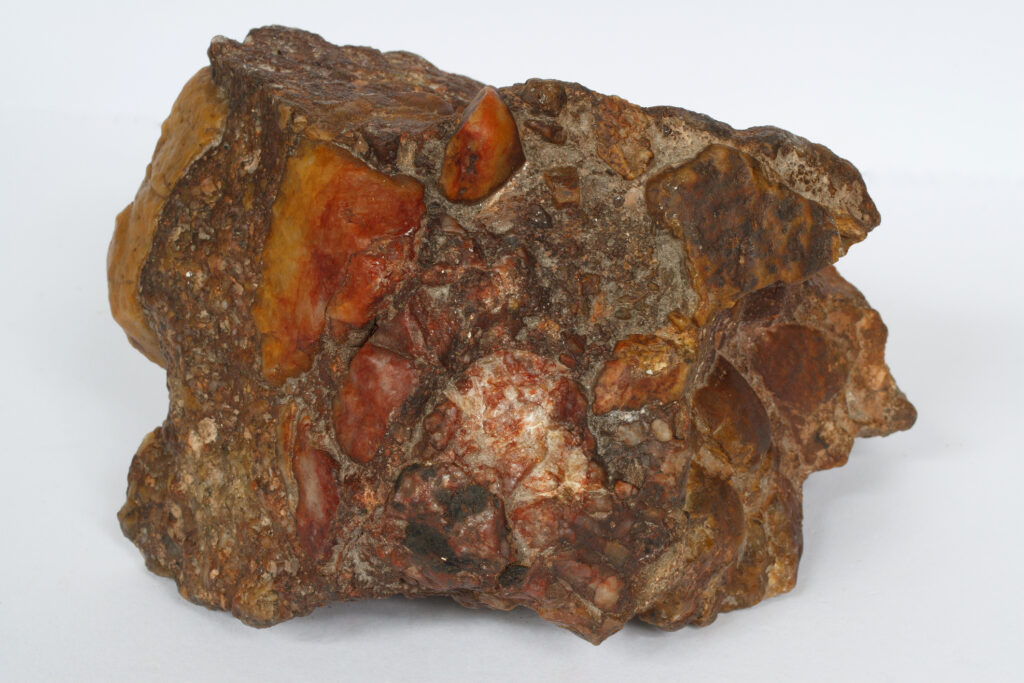
One of the most important observations you should make about your rock is about the presence, size, and shape of its grains.
When people think about rocks with grains they usually think about sedimentary rocks. Clastic sedimentary rocks will often have visible grains of varying sizes, but in some rocks like shales and mudstones the grains are too small to see with the naked eye. You may need a magnifying glass or gem loupe like this one from Amazon in order to see very fine grains. Most chemical and evaporate sedimentary rocks will not have visible grains.
Igneous rocks are subdivided into two categories that are expressed by grain size. Intrusive igneous rocks generally have large, visible crystals because they cooled underground and the crystals had time to organize and grow. Extrusive igneous rocks cooled more rapidly on the surface, and therefore they won’t have any visible grains.
For metamorphic rocks, the presence and size of grains is mostly determined by the protolith (the original, unaltered rock) and the degree of metamorphism. Sometimes when grains are present in a metamorphic rock they are the same crystals as were present in the protolith, but other times they are completely new crystals with different mineralogies, sizes, and orientations.
If visible grains are present, take note of the size distribution. Some rocks will be made up of grains that are all the same size (or very close), while others will have a variety of grain sizes. In sedimentary rocks, we refer to uniform grain sizes as ‘well-sorted’ while rocks with a variety of grain sizes are referred to as ‘poorly-sorted’.
It’s also important to observe the shape of the grains. Grains can be round, sharp or angular, or everything in between. This property is particularly important in the description of sedimentary rocks.
Foliation or Banding
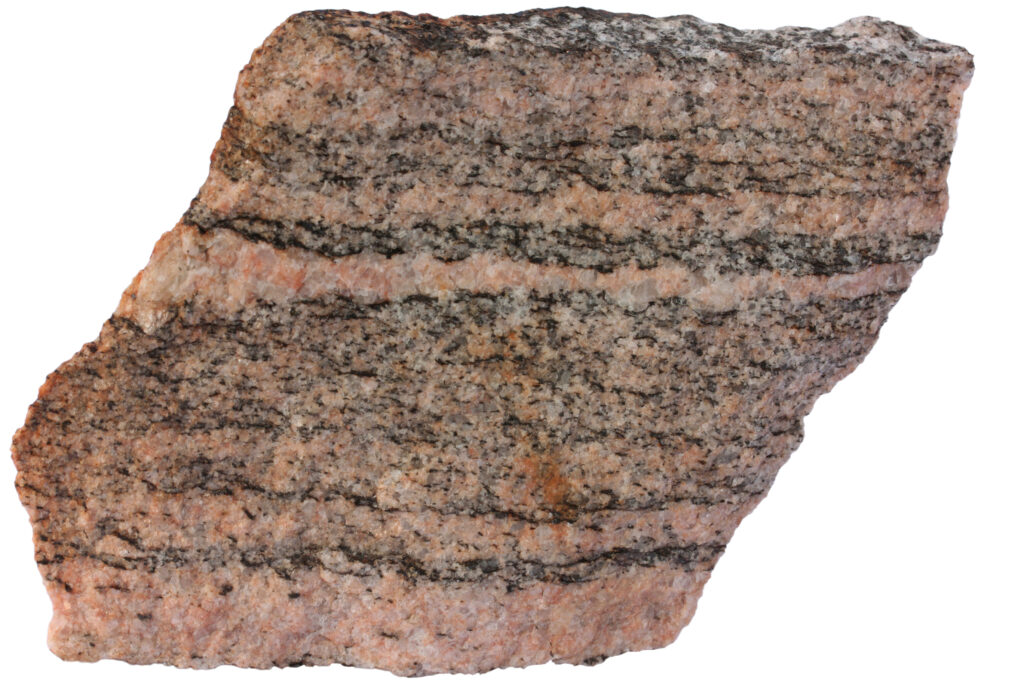
The presence of foliation or banding is a very strong indicator that your rock is metamorphic. The rock will display what looks like banding, caused by the compaction and elongation of crystal grains.
This type of banding is only present in metamorphic rocks, so it can really help narrow down what type of rock you have. If there is no foliation or banding present then it is much more likely that you have a sedimentary or igneous rock, because the grains are still more or less unchanged from their original shape.
It is important to distinguish between foliation and layering. Foliation refers to the orientation of elongated crystal grains. All of the grains will be stretched, and they will be lined up in one direction. If you look closely you will see that there are no consistent layers that run through the rock. Instead, the rock is fairly uniform with the elongated grains interlocking with one another.
Layering
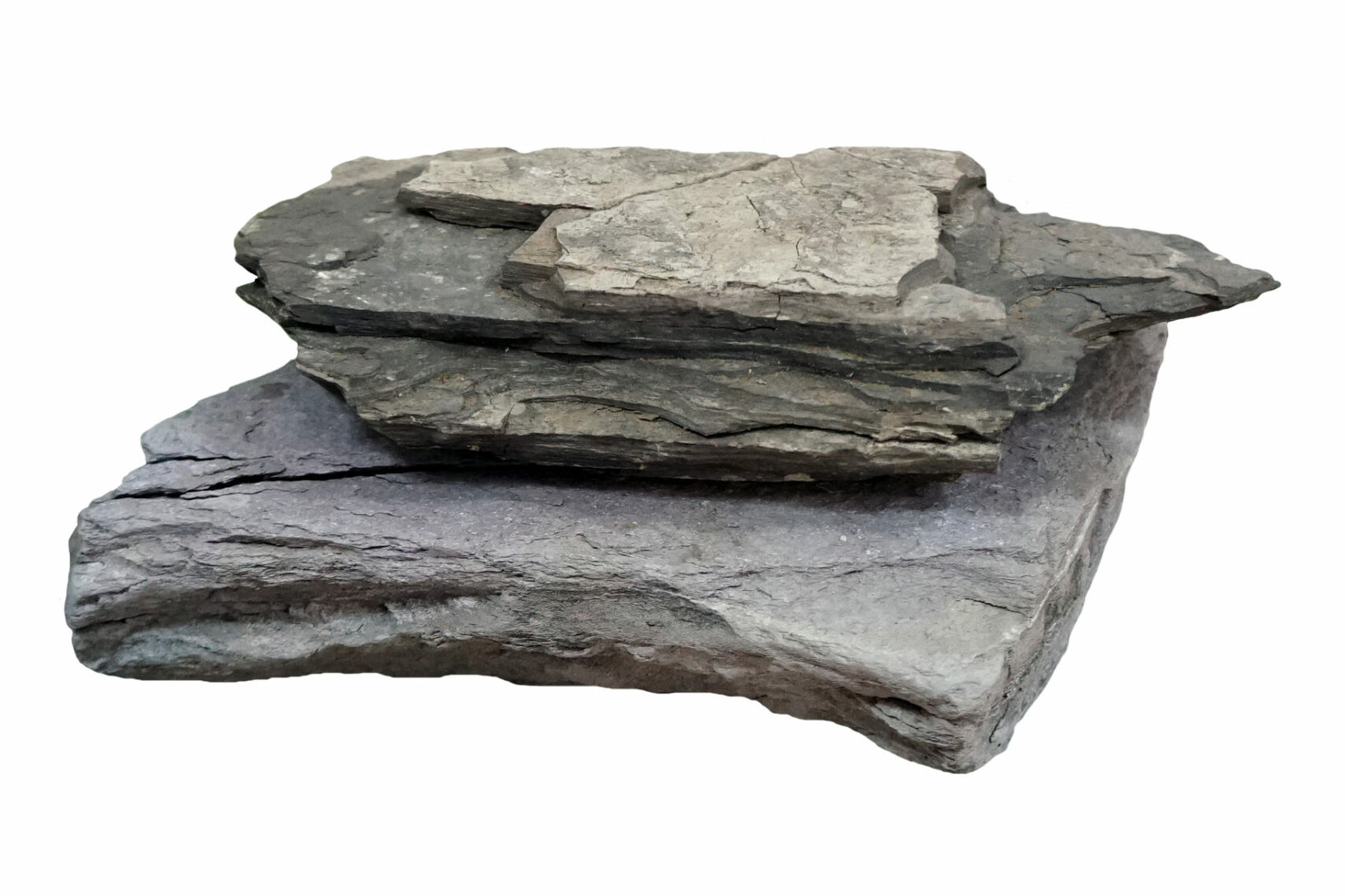
This leads us to the next important physical property to look for – layering. The layers you’re looking for are parallel beds that may be straight or curved. The layers may be very thin (about 1mm) or up to several inches thick.
Most layered rocks are sedimentary, but some are metamorphic. Layering is seen only rarely in igneous rocks. Sedimentary rocks are often layered because of the way they are formed, and metamorphic rocks can sometimes be layered if their protolith was. The presence and appearance of layering can be a big clue when trying to identify your rock.
Hardness
The hardness of a rock can be hard to quantify because most rocks are made up of several minerals which all have different hardnesses. Still, some basic tests can help narrow down what kind of rock you have.
In order to perform these simple tests, you’ll need a piece of glass and a steel nail (or other piece of steel). You’ll also be using your fingernails, but I’ll assume you already have those.
You can determine the general hardness of your rock by whether or not it can scratch or be scratched by your fingernail, glass, and steel. Try to scratch one of your fingernails with the rock. If it leaves a scratch, move on to the glass and do the same thing (keep the glass on a flat surface and take care not to break it). If your rock scratches the glass, move on to the steel and see if the nail will scratch the rock.
- Very Soft Rocks: Won’t scratch your fingernail, glass, or steel
- Soft Rocks: Will scratch your fingernail, but won’t scratch glass or steel
- Medium Rocks: Will scratch your fingernail and glass, but won’t scratch steel
- Hard Rocks: Will scratch your fingernail, glass, and steel
Weight and Density
For purposes of identifying your rock, all you usually need to do is take note of how heavy the rock feels compared to other rocks its size. When you pick it up, does it feel heavier than normal, lighter than normal, or about like you’d expect?
If you really want to get fancy you can perform specific gravity tests on your rock, but this is usually unnecessary. Because the mineralogy of rocks of a single rock type can vary, the density and weight will vary correspondingly. For example, the specific gravity of granite typically varies from 2.7 to 2.8 depending on the amount of quartz, feldspar, mica, and accessory minerals present.
Again, for our purposes, just hold the rock in your hand and see if it seems unusually light or heavy. This is usually enough to help with the identification process.
Texture and Feel
This test is a pretty easy one, but it’s also a little subjective. Run your fingers over the surface of the rock and see what you feel. Some rocks have textures that are unique enough that they can aid in identification.
Most rocks will simply feel coarse or rough, but if you feel something different be sure to make a note of it. Some rocks may feel glassy, slippery, greasy, or gritty. If you don’t feel anything notable that’s okay, too.
Unique Identifiers
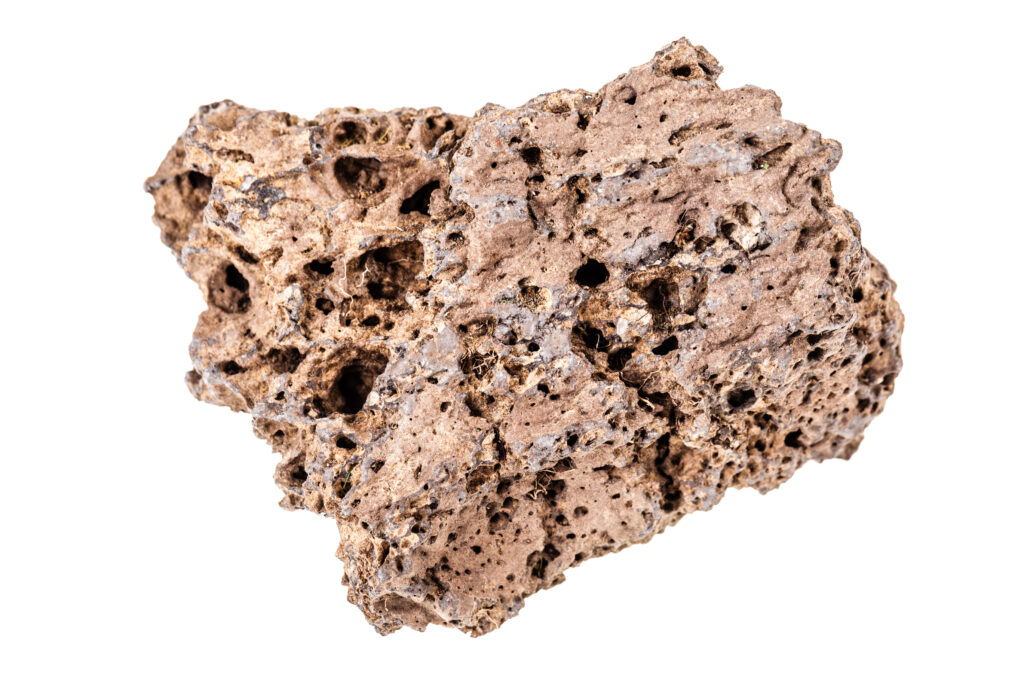
There are all sorts of other unique identifying characteristics that can help you identify your rock. Most of them are pretty specific and aren’t seen in very many rocks, so I’ve grouped them together here.
We’re looking for anything abnormal or that seems distinct about your rock. Things like bubbles in your rock, the presence of fossils, a reaction with weak acids, or interesting fracture trends can all help you figure out what sort of rock you have. These types of features are especially useful if you’ve already narrowed down your possibilities and you’re looking for anything else that can refine your choices.
Compare the Rock’s Properties to Known Rock Types
Now that you have analyzed your rock and made note of as many physical characteristics as possible, it’s time to actually find out what it is! You may already have a very good idea of whether your rock is sedimentary, igneous, or metamorphic, so I have divided the tables below accordingly.
Use these tables to find the rock type that most closely aligns with the properties of your rock. If you find a rock that is very close but doesn’t quite match, it may be worthwhile to go back and re-evaluate the physical properties that don’t align. Also, keep in mind that this list is far from exhaustive.
These tables are pretty comprehensive, but there may be uncommon rock types not listed here. Follow the links for more complete information on each rock type.
Sedimentary
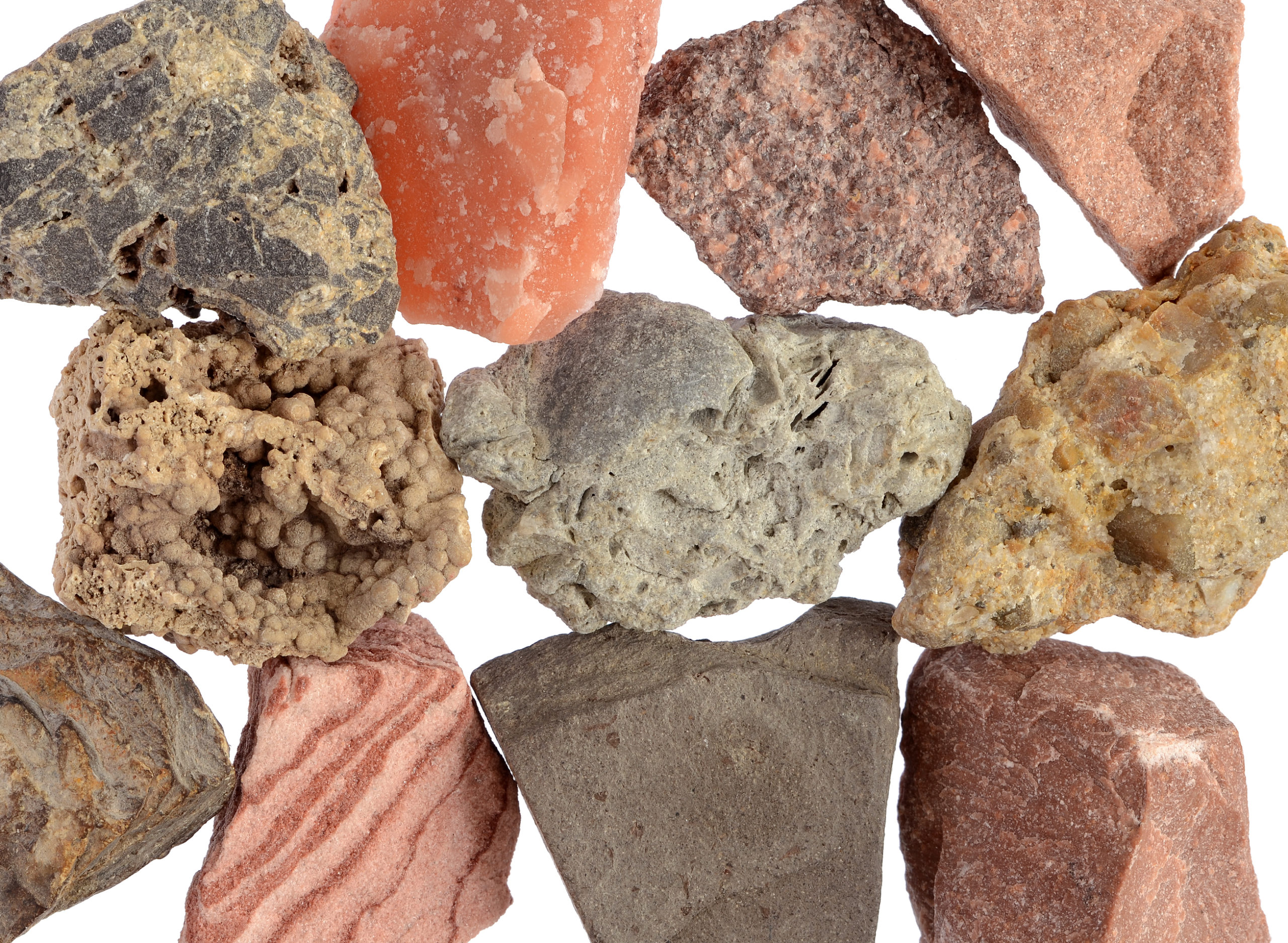
Sedimentary rocks are made up of mineral particles or rock fragments that have been cemented together. They are usually readily discernable from igneous and metamorphic rocks by the presence of grains, layers, and/or fossils. You can find my post dedicated to sedimentary rock identification here.
Sedimentary rocks are typically subdivided into three groups:
- Clastic sedimentary rocks are formed from rock fragments that have been cemented together.
- Biochemical sedimentary rocks are formed from skeletons, shells, and organic matter.
- Chemical sedimentary rocks are created when minerals precipitate out of solution.
| Rock Name | Composition | Grain Size | Hardness | Other Characteristics |
|---|---|---|---|---|
| Sandstone | Quartz, Feldspar | Medium | Hard | Many colors, mostly brown, tan, white, red, yellow |
| Shale | Clay minerals, Quartz | Very Fine | Hard | Thin layers, usually gray to black, fissile |
| Siltstone | Quartz, Feldspar | Fine | Hard | Many colors, not fissile, lacks clay minerals |
| Mudstone | Quartz, Feldspar | Very Fine | Hard | Not fissile, no layers, sometimes refers to limestone |
| Limestone | Calcite, Aragonite | Very fine | Soft | Often contains fossils, fizzes with acid, usually white or gray |
| Dolostone | Dolomite | Very fine to medium | Soft | Often confused with limestone. Only slight fizz on fresh surface |
| Breccia | Varied rock fragments | Fine to very large (varied) | Soft to hard (varied) | Similar to conglomerate, but with angular grains |
| Conglomerate | Varied rock fragments | Fine to very large (varied) | Soft to hard (varied) | Similar to breccia, but with rounded grains |
| Arkose | Feldspar, Quartz, rock fragments | Medium to coarse | Hard | Usually gray or red, similar to sandstone, but more feldspar |
| Greywacke | Quartz, Feldspar, rock fragments | Very fine to coarse (varied) | Hard | Dark gray color, angular grains, many grain sizes |
| Wackestone | Calcite, shell fragments | Very fine | Soft | Grains supported in mudstone |
| Coquina | Shell fragments | Medium to large | Medium to hard | Mostly shell fragments, can be poorly- or well-cemented |
| Evaporite | Halite, Gypsum, etc. | Coarse | Very soft | Rock formed from soluble minerals and evaporation |
| Chert | Quartz | Very fine | Hard | Many colors, very fine grains, conchoidal fractures. Includes Flint |
| Oolite | Calcite, Aragonite | Medium to large | Soft | Made of round ‘ooids’, can be white, gray, reddish |
Igneous
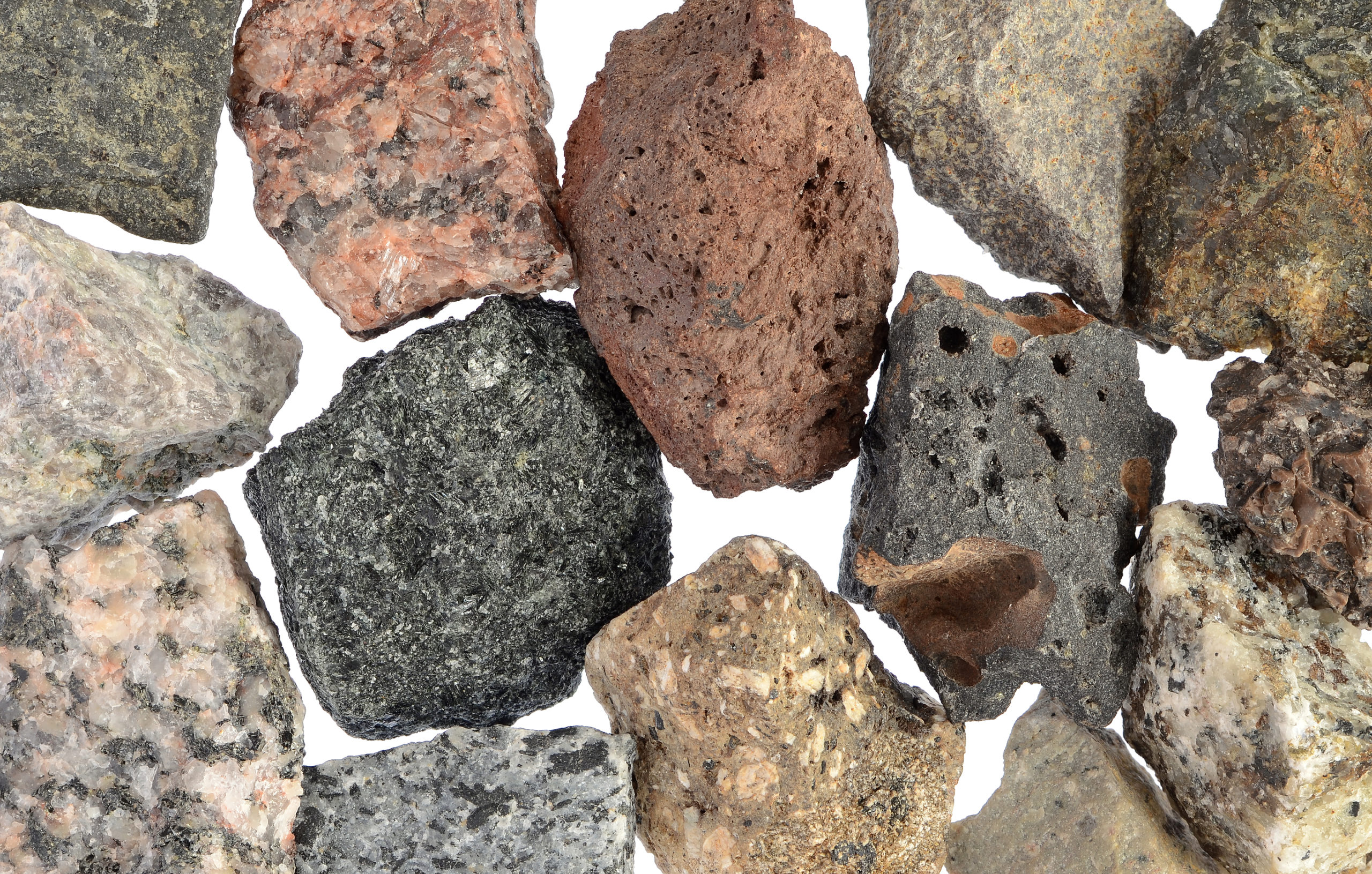
Igneous rocks are formed from the cooling and solidification of molten magma or lava. Their composition is determined by the chemical composition of the lava or magma from which it forms, while the degree of crystal formation is determined by the amount of time it takes for the magma or lava to cool. In addition to this article, you can find my post dedicated to igneous rock identification here.
Igneous rocks are subdivided into two general groups:
- Extrusive igneous rocks are formed from rapidly cooling lava on the surface.
- Intrusive igneous rocks are formed from slowly cooling magma beneath the surface.
| Rock Name | Composition | Grain Size | Color | Other Characteristics |
|---|---|---|---|---|
| Granite | Quartz, Feldspar, Mica or Amphibole | Coarse | White, Pink, Gray | Color and grain size highly variable |
| Rhyolite | Quartz, Feldspar | Very fine to glassy | Light color | Very high silica content, may contain larger crystals (phenocrysts) |
| Granodiorite | Quartz, Plagioclase | Coarse | Light gray, White & Black | High silica content, more plagioclase than alkali feldspar |
| Dacite | Quartz, Plagioclase | Fine | Light gray, White | High silica content, may contain larger crystals (phenocrysts) |
| Diorite | Plagioclase, Biotite, Hornblende, Pyroxene | Coarse | White and dark gray | Fairly rare, often confused with gabbro or granodiorite |
| Basalt | Augite, Pyroxene, Plagioclase, low-silica | Fine | Dark gray, sometimes light | Often has gas bubbles (vesicles). Can contain some larger crystals (porphyritic) |
| Diabase | Plagioclase, Augite, Olivine | Fine | Gray to dark gray | Sometimes called ‘microgabbro’. Fine but visible crystals |
| Gabbro | Augite, Pyroxene, Plagioclase, low-silica | Coarse | Gray to dark gray | Intrusive equivalent of basalt |
| Pumice | Highly varied | Very fine, glassy | Light | Many small gas bubbles (vesicles), floats in water |
| Scoria | Augite, Pyroxene, Plagioclase, low-silica | Very fine | Dark | Larger gas bubbles (vesicles) and vesicle walls than pumice. Usually does not float. |
| Obsidian | Quartz, feldspar | Glassy | Dark, light (rarely) | Conchoidal fractures, very sharp edges |
| Andesite | Plagioclase, Pyroxene, Hornblende | Fine grained, som large | Light to dark gray | Between basalt and rhyolite. Porphyritic texture (some large crystals) |
| Tuff | Highly variable | Very fine | Light to dark | Relatively soft, made of volcanic ash |
| Pegmatite | Quartz, Feldspar, Mica | Coarse to Very large | White, Pink, Gray, Varied | Resembles granite, but even bigger crystals |
| Syenite | Alkali Feldspar | Coarse | Light to medium | Similar to granite but lacking quartz |
| Dunite | Olivine, Pyroxene | Coarse | Green | Fairly rare. Almost entirely olivine crystals |
Metamorphic
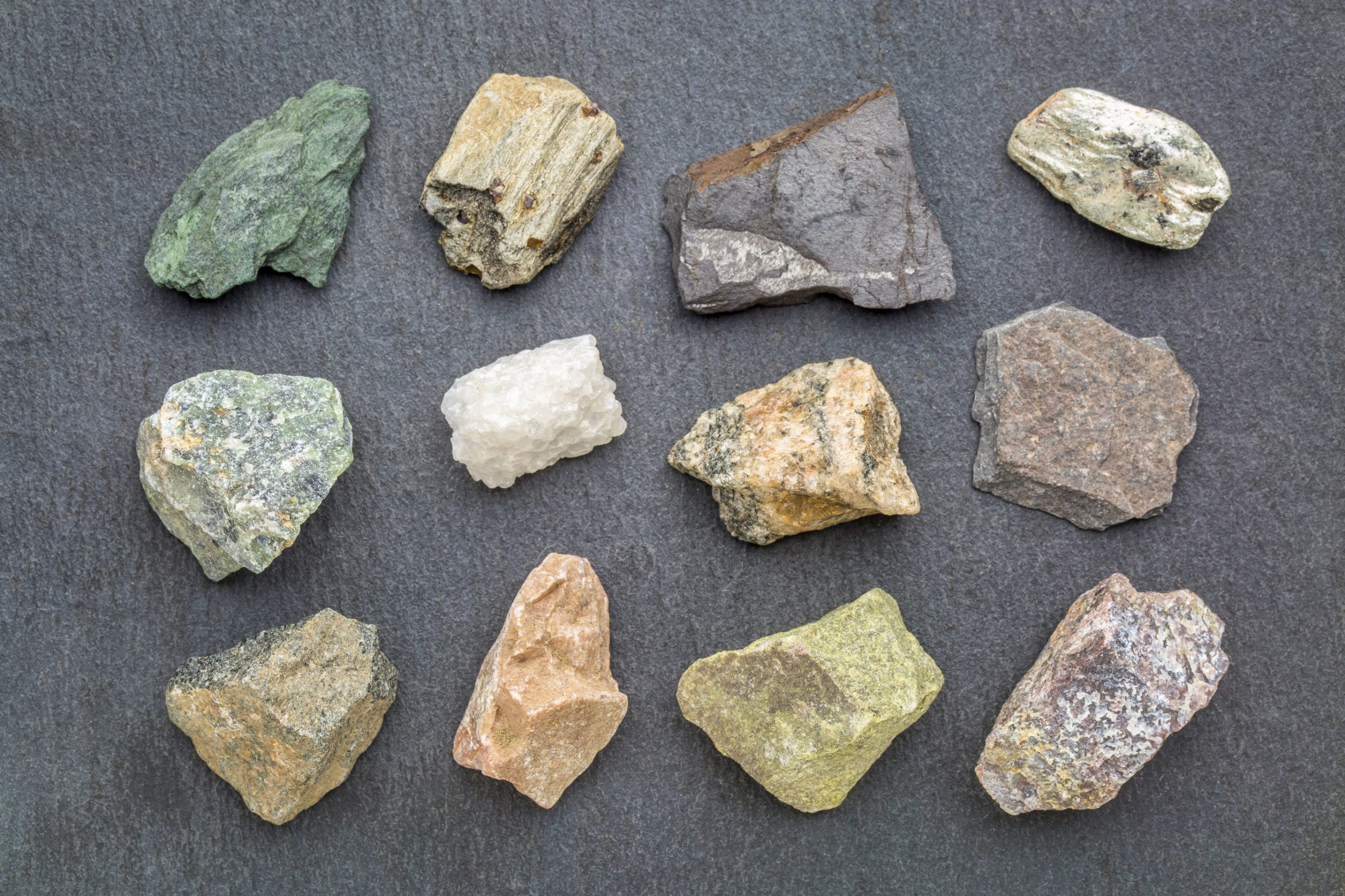
Metamorphic rocks are formed when existing rocks are subjected to heat and pressure, changing their shape, appearance, and composition. They are often distinguishable from other rock types by their foliation and the presence of characteristic metamorphic minerals like garnet, kyanite, and staurolite.
You can find my complete post about metamorphic rock identification here.
The type of metamorphic rock that is created depends on the original rock (known as the protolith) and the temperatures and pressures to which it has been subjected. Some rocks undergo multiple stages of metamorphism.
Metamorphic rocks are often loosely classified into three groups based on their texture
- Gneiss – Coarse-grained, thick (>5mm) foliation
- Schist – Medium grained, strongly foliated
- Granofels – No apparent foliation
| Rock Type | Composition | Grain Size | Foliation | Color | Other Characteristics |
|---|---|---|---|---|---|
| Gneiss | Quartz, Feldspar, Mica, Varied | Coarse | Yes | Light and dark | Alternating bands of light and dark |
| Schist | Mica, Chlorite, Quartz, Feldspar, Varied | Medium to Coarse | Yes | Light to dark | Platy, flaky texture. Defined by texture, so composition is highly variable |
| Marble | Calcite, Dolomite | Fine to coarse | No | Usually white, with swirls of other colors | Soft, metamorphosed limestone or dolostone |
| Quartzite | Quartz | Medium | No | White, Gray, Pink | Hard, metamorphose sandstone |
| Slate | Clay or volcanic ash, Quartz | Very Fine | Yes | Gray | Sometimes confused for shale, breaks into sheets |
| Phyllite | Mica, Chlorite, Quartz | Fine | Yes | Gray, Green | Silky luster, breaks into sheets |
| Serpentinite | Serpentine, Brucite, Magnetite | Fine | No | Light to dark green | Greasy feeling |
| Amphibolite | Hornblende, Actinolite, Plagioclase | Medium to coarse | Yes, weak | Dark | Dense, very little silica |
| Granulite | Feldspar, Quartz, etc. | Medium to coarse | No | Light | Red or pink garnet crystals common |
| Hornfels | Varied -Clays, Quartz, Feldspars, Hornblende, Calcite | Fine | No | Varied from light, dark, green, etc. | Very hard, originally sandstone |
| Skarn | Calcite, Dolomite, Garnet, Pyroxene | Coarse | No | Light to medium | Very hard, can form from sedimentary or igneous protolith |
| Soapstone | Talc, Chlorite, Amphibole | Fine | No | Light | Schistose or massive texture. Very soft, may feel like soap |
| Migmatite | Varied – at least two distinct rock types | Fine to medium | No | Light and dark | Clearly visible layers that may appear ‘melted’ |
Utilize Available Rock Identification Resources
If you’ve gone through the identification process I outlined above, chances are you’ll be able to get a solid answer about what type of rock you have. However, there are some additional tools available that could aid you in the process.
Some of these tools I have found very useful, while others are hit-and-miss. If you choose to use any of them I would still highly recommend making a note of all the physical properties of your rock that I outlined above.
Here are some of the most popular rock identification tools available:
- Smithsonian Handbooks: Rocks & Minerals – This book is the most useful I have found for help in identifying rocks and minerals. It has gorgeous pictures and nice descriptions of hundreds of rocks and minerals. The only drawback to a book like this is that it can sometimes be difficult to sift through to find a rock that matches yours. Even if you have gone through the process of documenting your rock’s physical properties, it can take a while to match it with a rock type in the book.
- The Rock Key – This tool is a little dated but the concept and information are great. Using many of the physical properties I listed above, you just answer questions about your rock and it moves through a flow chart until you land on an answer. It’s a little simplistic and doesn’t cover every type of rock, but for most major rock types it works very well.
- Stone ID App (Google Play) – This app uses AI and image recognition algorithms to identify what kind of rock you have. You can also find it on the Apple store here. I have found that this app (and others like it) is unreliable, but your mileage may vary. They rely on sophisticated algorithms that compare an image of your rock (taken from your phone) to thousands of others. Sometimes it works, and sometimes it doesn’t. If nothing else, it’s fun to play around with!
- What Is The Rock? Subreddit – This is a place dedicated to trying to figure out what kind of rock you have. It is often difficult to tell what a rock is based solely on pictures, so the more information you can provide (like the physical properties I listed above) the better. Take nice, well-lit pictures from multiple angles, and then make a post on the subreddit. Users (maybe even me!) can then discuss and make the best guess about what kind of rock you have.
By the way, if you want to learn all you can about rocks and minerals, I would highly recommend subscribing to Rock & Gem Magazine. They have great articles from knowledgeable and respected geologists and gemologists all about rock collecting, faceting, field trip ideas, and projects for kids. It’s a must for any aspiring rockhound!
Get an Outside Opinion, if Needed
If you have gone through all of these steps and you still haven’t come to a satisfactory answer, there are some additional measures you can take. Geology can be absolutely crazy sometimes, and there are a lot of rocks out there that can stump even the most experienced rockhounds.
The first thing I would suggest is to take your rock to a local rock shop, rockhounding club, or the geological survey for your state or country. You’ll find some experienced geologists and enthusiasts at these places who are likely extremely familiar with the local geology. This is particularly helpful if you found the rock locally – chances are that you’ll be able to find someone who has seen a rock just like yours.
Consider Alternative Explanations
I would advise you not to get too hung up on rocks that ‘look strange’. Some rocks have odd shapes or features that leave people scratching their heads. While these features can sometimes be useful for identification, they are often more distracting than anything else. Stay focused on the physical properties listed above when trying to identify your rock.
One last thing to consider is that what you find may not be a rock at all. I often see people posting pictures online asking for help identifying their ‘rock’ that is actually slag (a waste product formed from smelting), manmade brick or concrete, or colored glass. These types of finds can be really cool looking but can be confusing when people think they’ve found a rock.
In a similar vein, your rock may be a single mineral type. If you’ve found a crystal, gemstone, or other uniform-looking rock (especially if it displays any sort of crystal structure) you may be barking up the wrong tree. The rock identification methods in this article won’t be of much use, so you should instead use mineral identification techniques.

